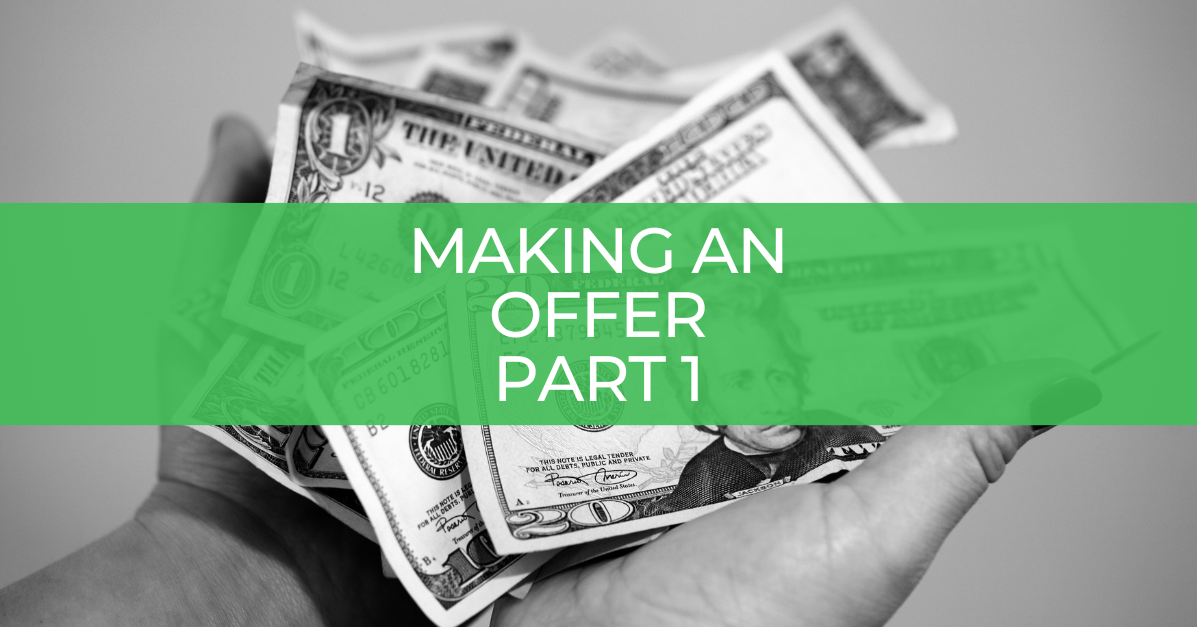
Making an Offer – Part 1 Homebuying Tips
Making an Offer
You finally found the perfect home and it’s time to place an offer. Your real estate agent will guide you through this process, but as the buyer, you have the final say in the offer and negotiations.
Initial Offer
Your initial offer is often your first contact with the seller. This is where your prequalification letter comes in handy. It proves to the seller you’re a serious buyer. The letter states a licensed lender reviewed your finances and credit. Barring any major complications, a loan approval will follow, and you can buy their house. The seller decides whether or not they accept your offer, so put your best foot forward. Understand they have emotions and memories attached to the house, and in a competitive market, politeness goes a long way with the seller.
Work with your real estate agent to create an offer that is fair and reasonable given the market conditions. Before placing your offer, do your research and compare other homes in the area that were recently sold to get an idea of the value of the home. Sold prices represent what people actually paid for the houses, so be sure to compare sold homes, rather than current listings. You should base your offer on a reasonable value of the home, not its list price.
Market Conditions
Oftentimes, how much you offer is determined by market conditions. The local market can vary from neighborhood to neighborhood. Discuss the local market with your real estate agent before placing your offer.
As a buyer, you have the most leverage in a buyer’s market. A buyer’s market is when there are more homes available than people looking. In this situation, the seller must meet more of your demands if they want to sell. You are most likely to win concessions in a buyer’s market.
Seller’s markets can be very competitive. The best strategy in a seller’s market is to make your offer as straightforward and attractive as possible. You can also write a cover letter that distinguishes you from the rest of the offers. When sellers have personal attachments to their home, a personalized cover letter can help them imagine you living there and creating your own memories.
Unlike a buyer’s market, you do not have much pull in a seller’s market. If the seller doesn’t like your offer, they won’t spend time negotiating with you because they know there are other buyers with better offers. In a very competitive market, buyers will offer above the asking price or even above value, but it is not necessary. Do not procrastinate in a seller’s market. If you find a house you like, you want to make an offer as soon as possible. If you wait too long, the house may already be gone. The saying goes, “if you want to sleep in it, don’t sleep on it.”
A balanced market means there are an equal number of buyers and sellers. In this market, personal priorities are most important, as neither side feels pressure from the market. Negotiations may take longer in this type of market, as both sides have equal power to get what they want. The usual outcome is an even split between the buyer’s and the seller’s terms.
Don’t Lowball
While it is perfectly acceptable to place an offer below list price, make sure you are offering a fair price to the seller. Don’t start the negotiations with a lowball offer. It taints the negotiations, and the seller may even refuse to respond.
If the house is priced above market value, you should include market data and a cover letter stating your position to the seller. That way they can understand your reasoning behind the offer.
Counter Offer
Negotiating the price is one of the most intimidating parts of buying a house. It is invaluable to have a real estate agent you trust to guide you through the process.
In the negotiations phase, be prepared to compromise. If the seller counters back with a new offer, you are responsible for either accepting their offer, declining it or countering back.
Try not to get caught up on a few thousand dollars. When negotiating, a few thousand dollars will not change your monthly payment by much. The chart below is a good reference for negotiations and shows the direct impact a change in price has on the monthly payment with a 30-year mortgage.
| Interest Rate | $ per month per $1,000 | $ per month per $5,000 | $ per month per $10,000 |
| 3.000% | $4.22 | $21.08 | $42.16 |
| 3.250% | $4.35 | $21.76 | $43.52 |
| 3.500% | $4.49 | $22.45 | $44.90 |
| 3.750% | $4.63 | $23.16 | $46.31 |
| 4.000% | $4.77 | $23.87 | $47.74 |
| 4.250% | $4.92 | $24.60 | $49.19 |
| 4.500% | $5.07 | $25.33 | $50.67 |
| 4.750% | $5.22 | $26.08 | $52.16 |
| 5.000% | $5.37 | $26.84 | $53.68 |
| 5.250% | $5.52 | $27.61 | $55.22 |
| 5.500% | $5.68 | $28.39 | $56.78 |
| 5.750% | $5.84 | $29.18 | $58.36 |
| 6.000% | $6.00 | $29.98 | $59.96 |
| 6.250% | $6.16 | $30.79 | $61.57 |
| 6.500% | $6.32 | $31.60 | $63.21 |
| 6.750% | $6.49 | $32.43 | $64.86 |
| 7.000% | $6.65 | $33.27 | $66.53 |
| 7.250% | $6.82 | $34.11 | $68.22 |
| 7.500% | $6.99 | $34.96 | $69.92 |
| 7.750% | $7.16 | $35.82 | $71.64 |
| 8.000% | $7.34 | $36.69 | $73.38 |
Now you’ve made your offer and negotiated a purchase price. Tune in next week to learn about the contingencies that impact a home purchase contract…
Need to get pre-qualified to go shop, contact E5 Home Loans to start the process or see what you could qualify to borrow. Already pre-qualified? Get a Second Opinion with E5 Home Loans to see how much you can save. We shop loan products across many lenders and we don’t charge a bunch of crazy fees.
